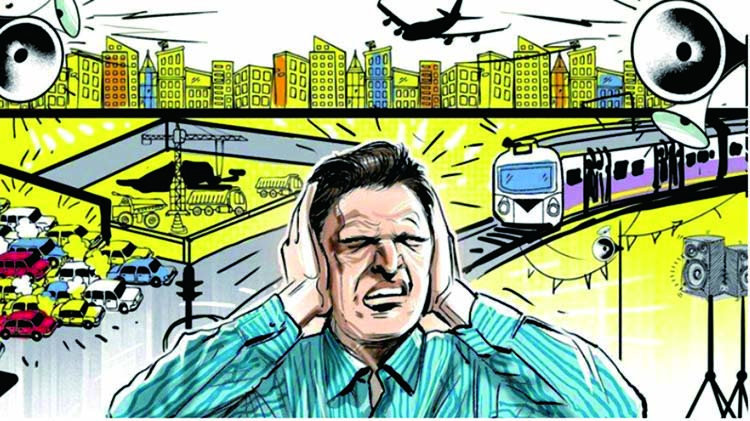Urban Soundscapes: Understanding Noise Pollution in Bangladesh

Shilajit Kumar Roy: Imagine being a resident of a university hall nestled beside the bustling highway with a unique wake-up call. It’s not the chirping birds, but the relentless cacophony of passing traffic that greets its residents every morning. This is a common sight for many, day in and day out. This daily overture, however, brings its own set of hurdles. Concentration can be a slippery friend when the city’s pulse reverberates through the walls. Lately, the excessive honking has turned into a city-wide woe. It’s a never-ending chorus that leaves residents frustrated by the constant noise.
Shockingly, this cacophony constitutes over half of the total noise pollution, making it the primary contributor. Adding to this cacophony, electric horns have emerged as a new disruptive force. These pesky noisemakers, commonly adorning cars and motorbikes, are wielded impatiently by drivers, adding to the chaos of our already bustling streets, and can be even more perilous than their hydraulic counterparts.
In the latest report from the United Nations Environment Programme titled ‘Frontiers 2022: Noise, Blazes and Mismatches’, Dhaka emerges as the leader in noise pollution, claiming the top spot. Following closely, Rajshahi, another city in Bangladesh, secures the fourth position in the rankings. As per World Health Organization recommendations, indoor spaces should resonate at a peaceful 55 decibels, while outdoor commercial areas can harmonize at 70 decibels.
The Department of Environment’s 2017 study unveils that sound levels in all divisional headquarters surpass safe thresholds for human hearing. Straying beyond permitted levels isn’t just a minor inconvenience – it is a threat to both physical and mental well-being. It brings a host of troubles: hearing impairments, high blood pressure, throbbing headaches, annoyance, sleep disturbances, persistent boredom, and various other health issues. This clearly violates the constitutionally assured right to life as stated in Article 32.
There are established laws in place to deter noise pollution but regrettably, these provisions seem to be more ink than action. According to the Noise Pollution (Control) Rules 2006, daytime sound levels should not surpass 50dB, dropping to 40dB at night in designated silent zones. Additionally, motor vehicles are allowed a maximum sound range of 85 decibels. It also identifies the quiet areas where horn usage is strictly forbidden by section 8.
The quiet areas, as per section 2(j), include hospitals, residential areas, educational institutions, offices, and similar establishments, and their surrounding 100-meter area. Section 18 states that producing noise pollution without authorization is punishable. A first-time offender may be fined Tk 5,000, imprisoned for one month, or both. Repeat offenders could face a Tk 10,000 fine, up to six months in prison, or both.
Besides, section 45 of the Road Transport Act 2018 makes it clear: vehicles must keep their noise levels in check, especially in designated quiet zones. Section 88 reinforces this, turning a violation of Section 45 into a punishable offense. Offenders may face a prison term of up to 3 months, a fine of no more than TK 10,000, or both. However, the enforcement authority rests with the Bangladesh Road Transport Authority, not the police. This explains why the police have little sway in curbing unnecessary or excessive horn usage.
In the realm of vehicle honks, hydraulic horns take the lead, producing a powerful 130 decibels of sound. However, according to Section 45(3) of The Road Transport Act 2018, any horn or device surpassing the recommended noise level is a strict no-go. In a landmark decision of 2017, the Supreme Court’s High Court Division prohibited the use of hydraulic horns, citing their environmental impact. The government was further directed to ensure rigorous enforcement of this ban. Continued honking beyond set limits isn’t just a disturbance – it’s also legally considered a public nuisance. According to section 268 of the Penal Code 1860, this action is subject to penalties. Offenders could face imprisonment for a period of up to two months, as outlined in section 290.
In the span of just a few decades, developing nations like Bangladesh have found themselves grappling with unprecedented environmental woes. One such formidable foe? Noise pollution, now acknowledged as a conventional environmental threat. The World Health Organization (WHO) ranks it as the third most concerning environmental issue in Bangladesh, trailing only behind air and water pollution.
While laws exist to tackle noise pollution, their effectiveness is often undermined by loopholes. Unfortunately, these gaps lead to widespread violations. In too many cases, lack of monitoring results in no action being taken. In conjunction with social awareness campaigns, enhanced collaboration among various concerned authorities, improved road discipline, stringent enforcement against banned hydraulic horns, effective monitoring systems, and a thorough reform of current legal frameworks could collectively contribute to reducing noise pollution to some extent.
The writer is an LL.B. 4th year student at Law Discipline in Khulna University.

